Post-war use of jet fighters by the Third Reich
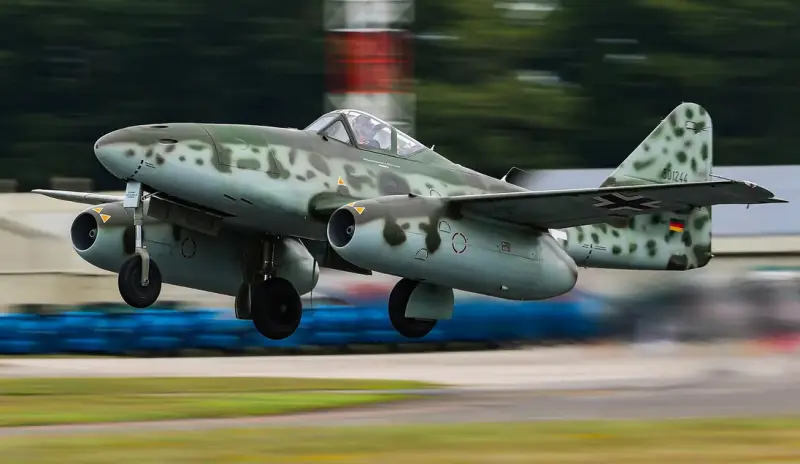
Work on the creation of combat aircraft with jet engines in Germany began in the 1930s, and thanks to the presence of a developed scientific and technological base, German designers during wartime were able to design, and production workers brought to serial production, several types of jet fighters.
After the end of World War II, German jet fighters were subjected to careful study, and aircraft assembled from German parts were used in the Czechoslovak Air Force for their intended purpose.
Messerschmitt Me 163 Comet
It is now quite obvious that fighter-interceptors with liquid rocket engines (liquid jet engines), having tanks with fuel and oxidizer on board, are a dead-end branch of the development of combat aviation. However, in the 1930–1940s, it seemed to designers that the liquid-propellant rocket engine, due to its high specific thrust impulse, was capable of providing excellent acceleration characteristics, and the influence of shortcomings, after gaining operational experience, could be minimized by introducing technical and organizational measures.
After the end of World War II, the use of liquid propellant engines in aviation followed the path of creating auxiliary power units. It was believed that a fighter with an additional engine, if necessary, could dramatically increase its speed and flight altitude, but this direction showed its futility in the late 1950s. Liquid jet engines have long been used on anti-aircraft, cruise and ballistic missiles, and are still installed on launch vehicles designed to launch payloads into space and onto spacecraft flying beyond the Earth's orbit.
In Nazi Germany, several types of fighters equipped with liquid propellant engines were created. However, only the Me 163 was able to be brought to the stage of mass production and used in combat.
When designing the tailless jet interceptor, much attention was paid to making it as simple and inexpensive as possible. The wing had a wooden structure and variable sweep along the leading edge. Take-off was carried out on a drop-down trolley, and landing on a release ski.
To operate a jet engine, two components were used: fuel and oxidizer, the reserves of which were stored on board the aircraft. An extremely toxic mixture was used as fuel, consisting of 30% hydrazine hydrate and 58% methanol with an admixture of water (486 kg). The oxidizing agent was 80% hydrogen peroxide (1 kg). When fuel and oxidizer came into contact, they spontaneously ignited, which made it possible to do without an ignition system in the engine, but in case of leaks it repeatedly led to explosions and fires.
The first flight of the prototype using a jet engine took place in August 1941. Already during the first test flights, it was possible to reach 800 km/h, which exceeded the official world record at that time. The maximum result shown when starting from the ground was 920 km/h; there was not enough fuel for more, since the engine operating time was initially a little over 4 minutes.
The prototypes were equipped with a Walter HWK 509A-0 engine with thrust adjustment within the range of 300–1 kgf. The serial Me 500B-163 interceptors received a Walter HWK 1A-509 rocket engine with a thrust of 2–100 kgf, which provided a thrust-to-weight ratio of more than 1. The improved Me 700C-0,4 interceptor, which was not brought to mass production, was planned to be equipped with a Walter HWK 163C-1 two-chamber engine with a maximum thrust of 509 kgf.
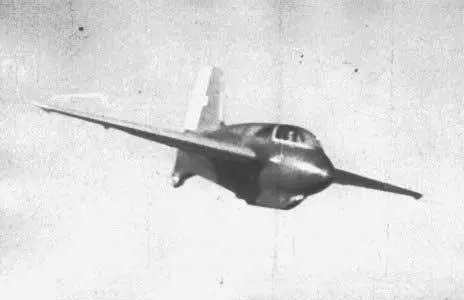
The engines installed on experimental and production aircraft had systems for starting, stopping, throttling and supplying components in a given ratio, as well as various types of protection and blocking. The combustion chamber and nozzle were cooled by fuel, which then entered the pump inlet. In general, the design of the Walter HWK 509 family of rocket engines was very advanced for that time, but it would have been more suitable for a remotely controlled anti-aircraft missile.
The features of the two-component jet engine predetermined the main disadvantages of the Comet. The interceptor, which had very high acceleration characteristics, had a continuous engine operating time of no more than 8 minutes, which did not always allow it to take an advantageous position for an attack and, as a rule, excluded a repeated approach to the target. In addition, to adjust the flight speed it was necessary to have some experience.
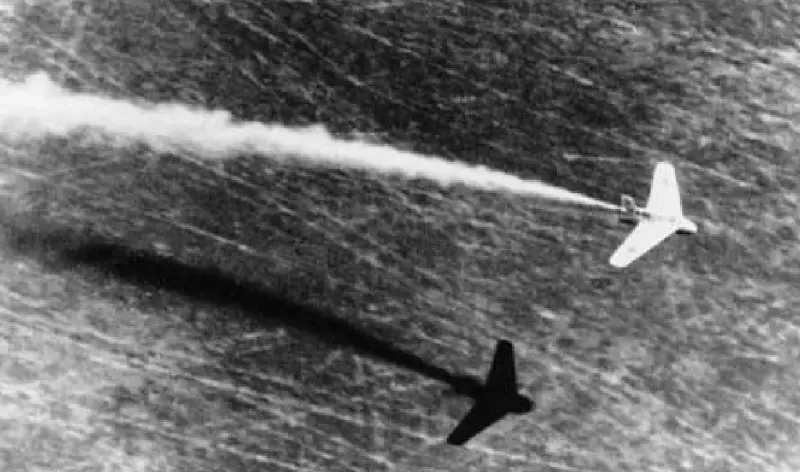
Pilots tried to control the speed of approach to the target by turning the engine off and on in combination with performing slides and slides. But such manipulations required refined piloting techniques and were very complex and dangerous to perform. After stopping the engine, the interceptor pilot controlled it like a glider and landed on a retractable steel ski.
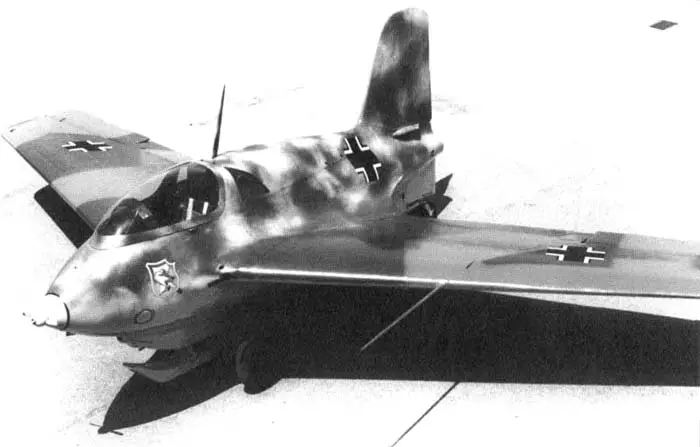
Me 163B-1
The serial interceptor Me 163B-1 had a maximum take-off weight of 4 kg. When flying at sea level, the jet engine provided a speed of 110 km/h, and at an altitude of 830 m – 3 km/h. Flight range is about 000 km. The service ceiling is 960 m. The aircraft could rise to an altitude of 200 m in less than 12 minutes.
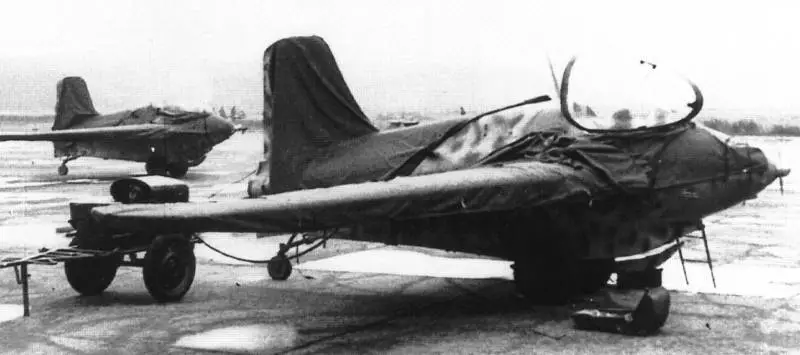
The first examples were armed with two 20-mm MG 151/20 cannons with 100 rounds of ammunition per barrel. Most of the serial interceptors were equipped with two 30-mm MK-108 cannons with 60 rounds of ammunition per barrel. From the front, the Comet pilot was covered by a bow made of 15 mm steel armor and bulletproof glass. An armored back 8–13 mm thick protected from attacks from behind.
Data on the number of Me 163s produced vary, but most sources agree that there were no more than 400 units. German sources claim that Me 163 pilots shot down 16 aircraft (mostly heavy bombers). However, American historians confirm the loss of only 9 reconnaissance aircraft and bombers. In turn, American and British fighters claim 6 downed Komets; it is not known how many Me 163s were hit by the bombers’ side gunners. But most of the missile interceptors and their pilots were lost during flight accidents associated with piloting errors, explosions and fires caused by fuel leaks or abnormal engine operation.
English-language sources claim that at least 29 serviceable Me 163s fell into Allied hands. One interceptor was tested in flight by British captain Eric Brown in May 1945.
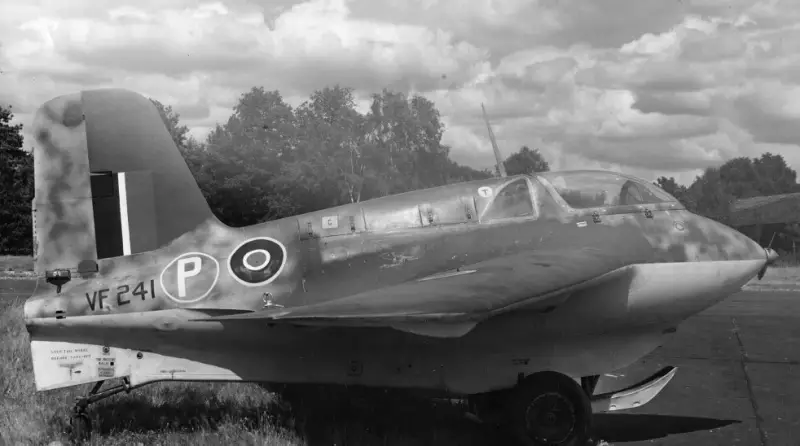
The preparation of the aircraft for departure from Khosum airfield was carried out by German ground personnel.
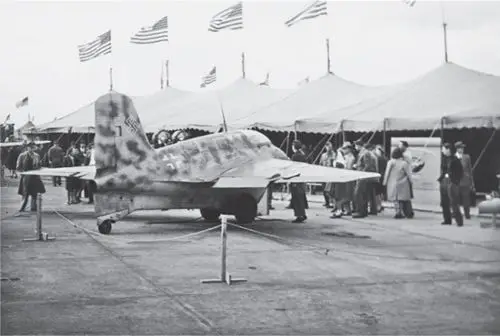
Interceptor Me 163B-1 at the American exhibition Wright Field in October 1945
Several Komets made it to the United States, but there is no information about their flights using liquid propellant engines.
By the end of 1945, ten Me 163 fighters were delivered to the Soviet Union (seven of them were two-seat trainers).
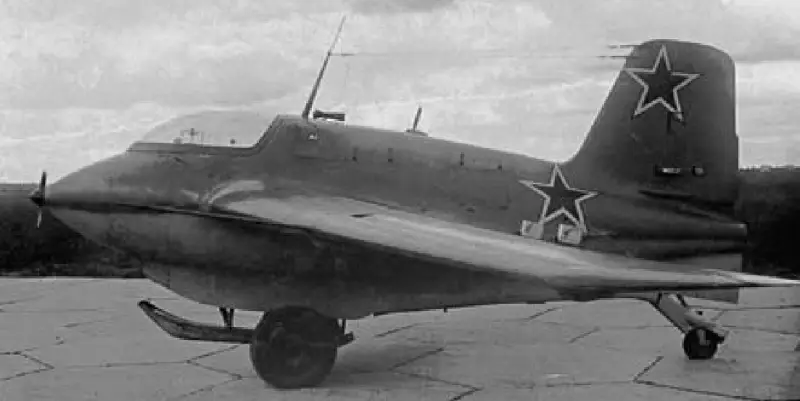
After studying these aircraft, they were deemed not worth copying. In the USSR in 1942–1943. The BI-1 fighter, equipped with a D1-A-1100 liquid-propellant rocket engine with a thrust of 1 kgf, running on nitric acid and kerosene, had already been tested, and all the main disadvantages of such an interceptor were known.
There are currently 10 surviving Me 163s on display in museums. In the mid-1990s, former Comet pilot Joseph Kurtz built a flying replica of the Comet.
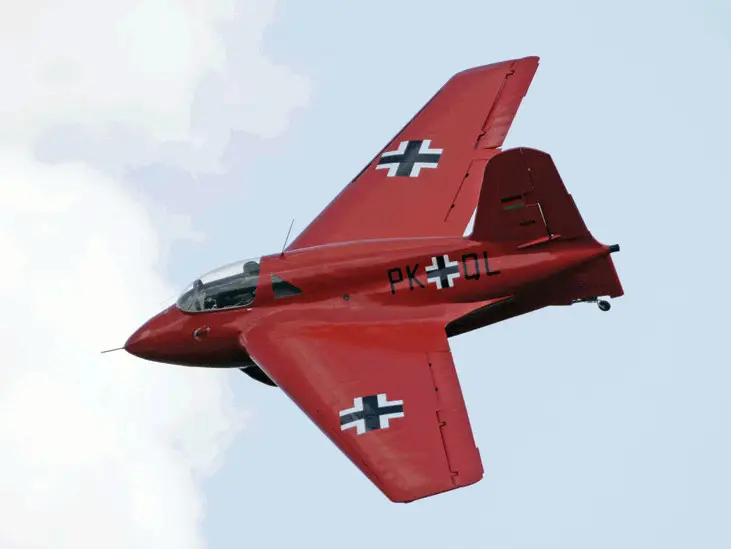
This device does not have an engine, and it is lifted into the air by a towing aircraft. After uncoupling from the tug, it flies like a glider.
Messerschmitt Me 262 Schwalbe
The only German jet fighter that was not only mass-produced in noticeable quantities, but also forced to be taken into account by taking part in hostilities, was the Me 262, also known as Schwalbe - “Swallow”.
The design of this aircraft began in 1938. Unlike a number of other experimental vehicles that were being worked on in Germany at that time, the Me 262 was considered from the very beginning as a combat fighter.
In the design version, turbojet engines were planned to be installed on the sides of the fuselage, which was explained by the desire of the designers to reduce drag and improve controllability in the event of failure of one turbojet engine. However, the existing engines were too large, and they were placed under the wing.
The final version of the Me 262 had a triangular fuselage section with rounded corners, and the width of the base of this triangle was noticeably greater than the height.
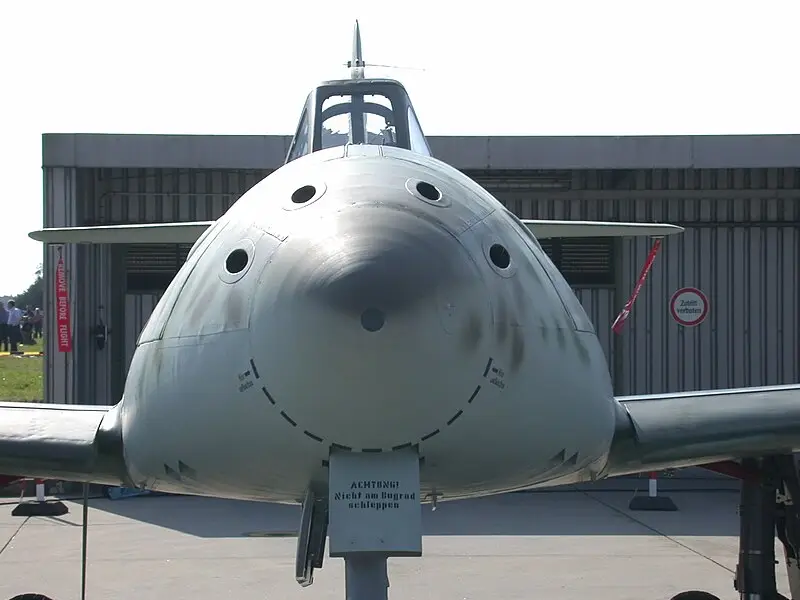
The wing sweep angle along the leading edge was 18º. However, the use of a swept wing on the Me 262 is not associated with the optimization of aerodynamic surfaces for high flight speeds, but with the need to ensure the required range of alignments and, as a consequence, the required margin of longitudinal stability of the fighter. Nevertheless, compared to other German jet and piston fighters, the Lastochka had very good aerodynamics.
Due to the high degree of novelty and the unavailability of the turbojet engine, the first Me 262V1 prototype, which took off on April 18, 1941, was equipped with a Jumo 12G piston 210-cylinder liquid-cooled engine with a power of 750 hp. With.
The plane, powered by two BMW P3302 turbojet engines and a piston engine, took off on March 25, 1942 and, due to the failure of both turbojet engines, almost ended in disaster.
It was possible to continue testing after receiving the Junkers Jumo 004 turbojet engine. Compared to the BMW P3302, they were larger, and therefore the engine nacelles had to be redesigned.
Testing and development of the Me 262 was very difficult, and several prototypes were lost in flight accidents. Only at the beginning of 1944, 30 pre-production Me 262A were manufactured, intended for trial operation. In the summer of 1944, production Me 262A-1 fighters began to enter service with the troops.
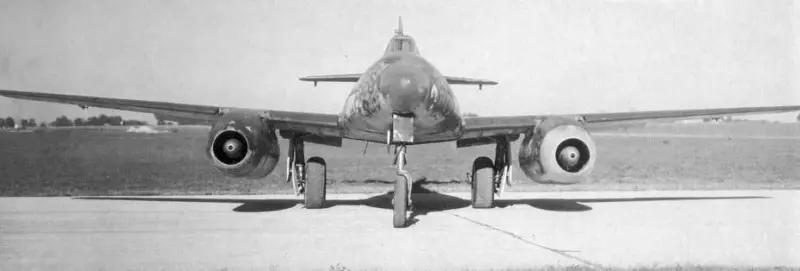
Me 262A-1
The jet fighter with a maximum take-off weight of 7 kg was equipped with two Junkers Jumo 140B-004 turbojet engines with a thrust of 1 kgf each. Maximum flight speed is up to 900 km/h. Practical range – 855 km. Practical ceiling – 1 m.
The fighter's armament consisted of four 30-mm MK 108A cannons with 100 rounds of ammunition for the upper guns and 80 for the lower ones. Some fighters were armed with two 20-mm MG 151 cannons with 146 rounds of ammunition and two 30-mm MK 103 cannons with a total ammunition load of 144 rounds. 55-mm R4M missiles with an effective firing range of up to 1 m were used against air targets. Up to 500 such missiles could be suspended under the interceptor’s wing, mainly intended to combat enemy bombers.
Based on the Me 262A-1 fighter, a number of Me 262A-2 attack aircraft were manufactured. This aircraft also had the name Sturmvogel - “Petrel”. The Burevestnik's built-in armament consisted of two 30 mm cannons. The external sling could accommodate a bomb load weighing up to 1 kg. However, no combat successes of the Me 000A-262 “bombers” are known.
Based on the Me 262, a high-speed reconnaissance aircraft, two-seat night fighters, interceptor fighters equipped with an additional rocket engine, as well as “formation destroyers” armed with 50 mm cannons were also developed.
Before the surrender of the Third Reich, they managed to deliver a little more than 1 Me 400 of various modifications, mostly fighters. At the same time, there were usually no more than 262 aircraft available in combat readiness, due to logistical and operational problems, as well as a lack of qualified flight and technical personnel. All this affected the results of combat use. During air battles, pilots of Me 100 fighter modifications, according to German data, shot down about 262 enemy aircraft with their own combat losses of approximately 300 aircraft.
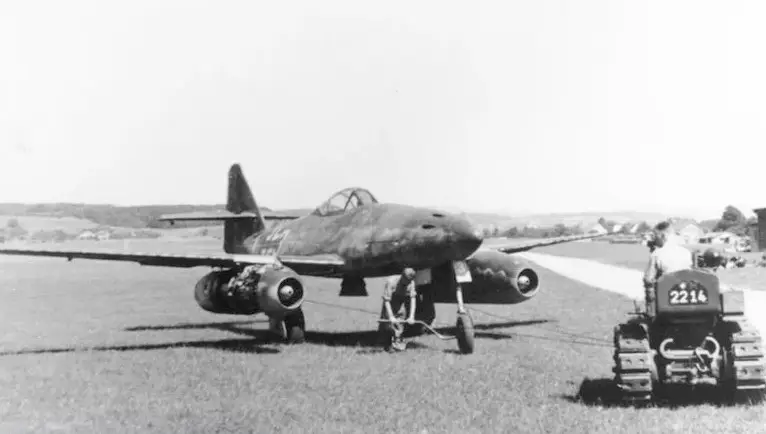
Pilots who mastered the Me 262 noted that this fighter was easier to fly than the piston-powered Bf 109. At the same time, the jet aircraft had a number of features that needed to be taken into account.
Despite the fact that the “Swallow” was significantly superior in flight speed to all production fighters of World War II, its acceleration characteristics left much to be desired. Jumo 004 engines had poor throttle response and often stalled or caught fire with a sharp increase in speed. Because of this, the Me 262 could not accelerate as quickly as a piston-engined fighter.
Taking into account the fact that the jet aircraft had poor horizontal maneuverability, battles on turns and low-altitude flights were contraindicated for it. Turbojet engines, with a designated service life of 25 hours, often failed earlier, and landing the Me 262 with one working turbojet engine was very dangerous. If the established maximum flight speed was exceeded, there was a risk of the aircraft being pulled into a dive or the airframe being destroyed.
Although the Lastochka turned out to be very “crude”, required fine-tuning and had a number of significant design flaws, when used as an interceptor fighter by the standards of the mid-1940s, this aircraft generally performed well. This was indirectly confirmed by tests of captured Me 262s in the UK and the USA.
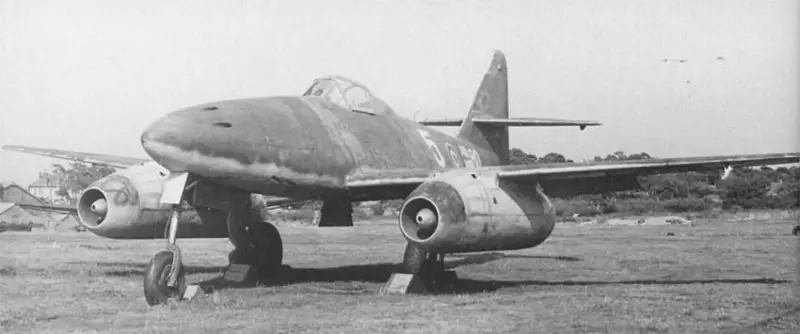
Me 262A-1 undergoing testing in the UK
The British who flew the Me 262A-1 noted that this aircraft was faster and more stable in flight than the Gloster Meteor F1, and also had better visibility from the cockpit. In addition, the weaponry, much more powerful than that of the Meteor, predetermined the superiority of the Lastochka when used as an interceptor.
The Americans, as part of the LUSTY (Luftwaffe Secret Technology) program, organized a large-scale collection of the latest German missile and aviation technologies. Operation Sea Horse was organized to transport captured aircraft to the United States.
As part of this operation, the Americans leased the escort aircraft carrier HMS Reaper, built in the United States for Great Britain. The loading of captured German aircraft aboard the aircraft carrier took place in July 1945 in the port of Cherbourg. To protect the aircraft from the effects of salt spray, they were covered with a protective film.
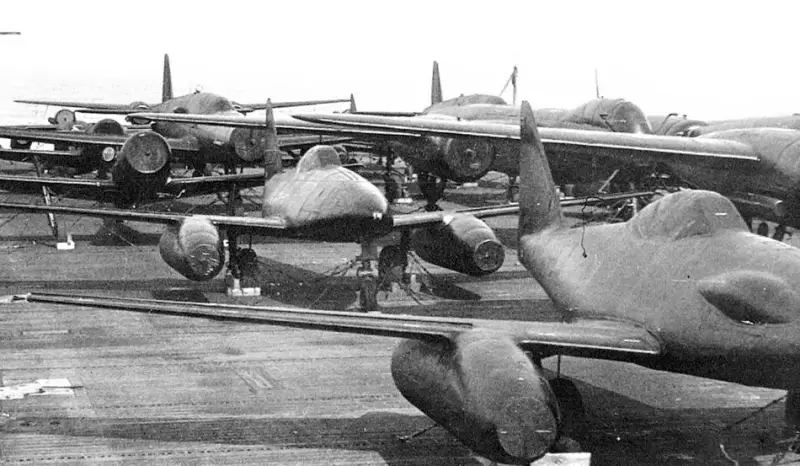
In addition to ten Me 262s, the ship was loaded with 9 Fw 190 of various modifications, 1 Ta 152, 4 Ar 234, 3 He 219, 1 Bf 108, 3 Bf 109, 2 Do 335, 2 Bü 181, 1 WNF 342, 2 Fl 282, 1 Ju 88, 1 Ju 388 and 1 Ho 229 V3.
The German aircraft were first delivered to Newark Army Airfield in New Jersey and then distributed among flight test centers.
The Americans, having compared the Me 262 with the Lockheed P-80 Shooting Star, came to the conclusion that the Swallow was faster and better armed than their first production jet fighter.
The first Me 262A-2, which made an emergency landing on territory controlled by the Red Army, was delivered to the USSR in March 1945.
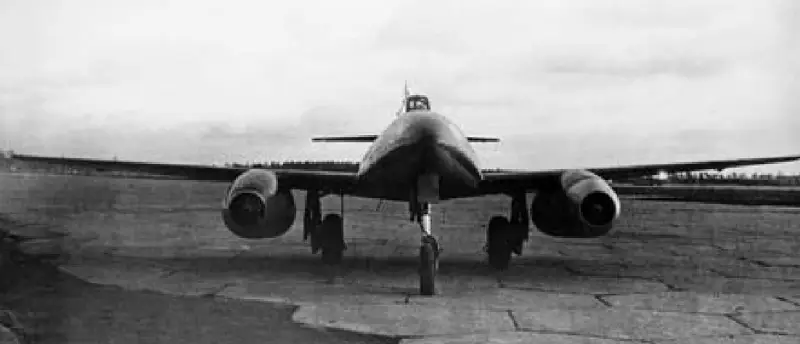
Me 262A-2 from the JG7 squadron made an emergency landing in Schweidemühl
In the summer of 1945, Soviet captured teams discovered three serviceable aircraft and several usable Jumo 004 engines. At least one Me 262 was tested at the Air Force Research Institute.
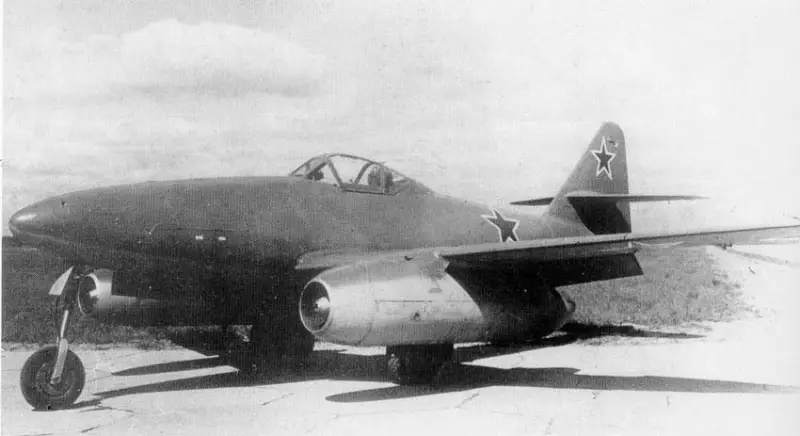
Based on the test results, representatives of the NKAP came up with a proposal to copy and launch the Me 262 into mass production to quickly reduce the USSR's backlog in the field of jet aviation.
In 1946, based on the Me 262, the Sukhoi Design Bureau created the Su-9 fighter. The only prototypes of these machines built were equipped with captured German Jumo-004B engines. The built-in artillery armament consisted of one 37 mm cannon with 45 rounds of ammunition and two 23 mm cannons with a total ammunition capacity of 200 rounds. In addition, provision was made for the suspension of two 250 kg bombs.
The experimental aircraft with a maximum take-off weight of 6 kg at an altitude of 380 m in horizontal flight accelerated to 5 km/h. The practical flight range was 000 km. Service ceiling – 885 m.
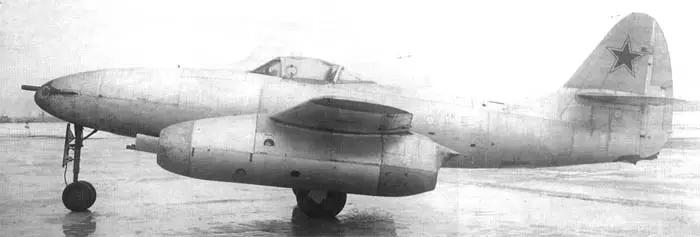
Su-9
Along with other models of new technology, the Su-9 was demonstrated during an air parade held in Tushino near Moscow on August 3, 1947. But by that time, the Air Force leadership believed that the Soviet copy of the Me 262, despite a number of positive aspects, had no further development prospects, and preference was given to domestic designs.
The only country where Me 262 fighters were in service in the post-war period was Czechoslovakia. This happened due to the fact that at the end of World War II, the German leadership, in connection with the destructive Anglo-American bombings, decided to disperse production facilities for the production of jet fighters and move their assembly to Austria and the Czech Republic.
After the surrender of Germany, the Czech aircraft manufacturer Avia was left with a full range of components (including Jumo-004 aircraft engines), from which nine single-seat jet fighters and three training twins were assembled between 1946 and 1948.
Single-seat aircraft were designated S-92, double-seat aircraft - CS-92. The flight of the first S-92 jet fighter took place at the end of August 1946. All available S-92 and CS-92 were combined into the 5th Fighter Squadron, which was based at the Mlada Boleslav airfield, 55 km north of Prague.
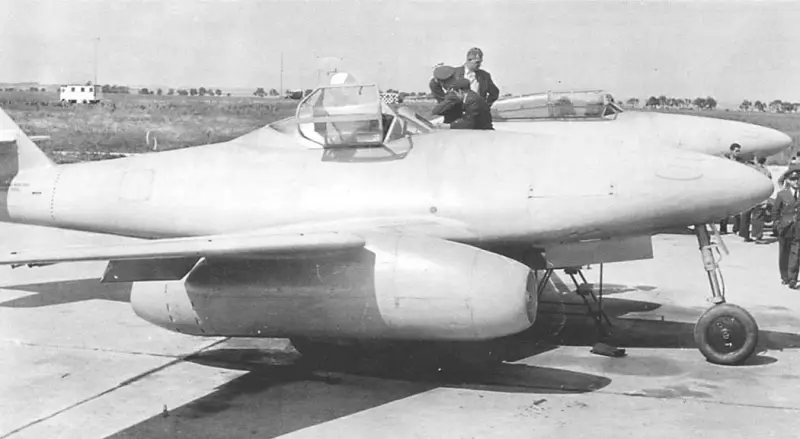
S-92 jet fighters
Due to the small number and constant problems with Jumo-004 turbojet engines, the S-92 and CS-92 fighters did not have much combat value. Their operation was short-lived; all jet fighters assembled from German components were written off in 1950.
At the beginning of the 21st century, the American company Texas Airplane Factory, which specialized in the construction of copies of old aircraft with historical value, built flying replicas of the Swallow. In this case, original drawings and a restored Me 262B-1a that belonged to the US Navy were used.
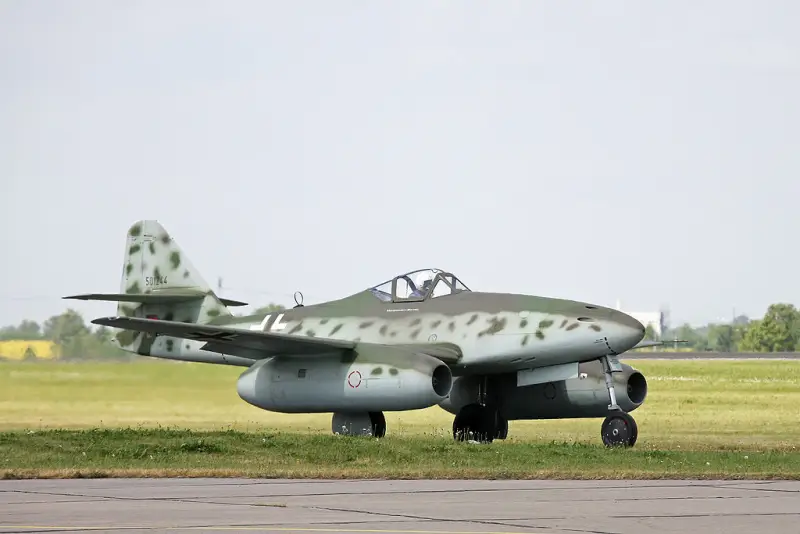
A flying replica of the Me 262 fighter jet at the 2006 ILA Berlin Airshow
Since it was impossible to use the original Jumo-004 turbojet engines for many reasons, the replicas were equipped with General Electric J 85-CJ-610 engines with a thrust of 1 kgf each. A total of two aircraft were built. One copy was sold to a private collector from the USA; the buyer of the second aircraft was the German Messerschmitt Foundation.
Heinkel He 162 Volksjäger
If the Me 262 fighters had appeared earlier, were produced in large volumes and had been brought to the required level of reliability, then they could have had a significant impact on the course of hostilities and significantly reduced the effect of raids by American and British heavy bombers.
One of the factors preventing the mass production of the Me 262 was the high cost of production of this aircraft. Thus, the price of one “Swallow” approximately corresponded to the cost of four Bf 109G.
In this regard, as part of the Jägernotprogramm, which provides for the creation of an inexpensive and mass-produced air defense interceptor, Heinkel Flugzeugwerke proposed the He 162, also known as Salamander - “Salamander”, and Volksjäger - “People’s Hunter” or “People’s Fighter”.
According to the requirements of officials of the Ministry of Armaments, the "People's Fighter" had to be built from the best available materials and be cheap, and its assembly could be carried out by low-skilled labor.
The He 162 aircraft was created in an unprecedentedly short time; 90 days passed from the start of work until the completion of the prototype aircraft.
The first experimental He 162V1 flew on December 6, 1944. During a 20-minute flight, the prototype reached a speed of 835 km/h at an altitude of 6 m. Simultaneously with the testing of the prototype, preparations for serial production were underway.
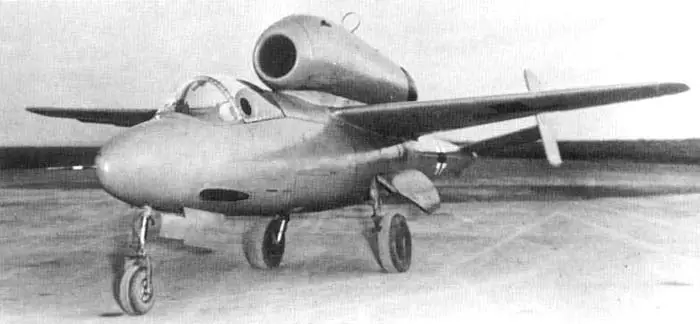
Not 162V1
Since duralumin was sorely in short supply, the He-162's structure consisted mainly of wood. The He 162 had a monocoque structure made of light alloy, with a nose cone made of bent plywood. The wing was made of wood with plywood skins and removable metal wingtips. The tail, elevators and rudder were made of light alloy, and the keel was made of wood. The BMW 003 Sturm turbojet engine was bolted to the top of the fuselage.
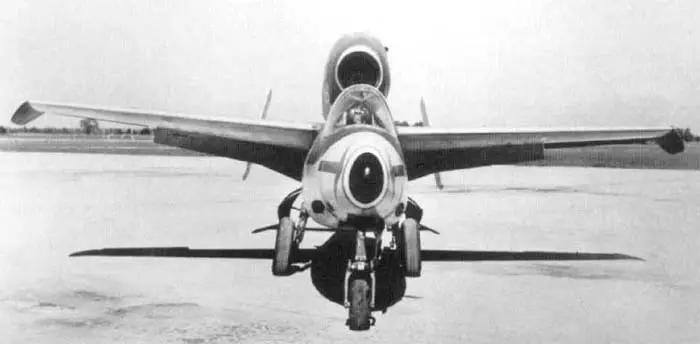
He 162A-2
The serial fighter of the He 162A-2 modification had a maximum take-off weight of 2 kg. The BMW-800E-003 turbojet engine developed 1 kgf of afterburner thrust. At an altitude of 920 m, the maximum speed was 6 km/h. Practical range is about 000 km. Service ceiling - 900 m. The He 950A-12 interceptor was armed with two 000-mm MG 162/2 cannons with 20 rounds of ammunition per barrel; the He 151A-20 modification was equipped with two 120-mm MK 162 cannons with 1 rounds of ammunition per barrel. .
The release of He 162 received priority over all other weapons production programs. The planned production volume by May 1945 was to exceed 2 units. The assembly of the "People's Fighter" was to be carried out at five different aircraft manufacturing enterprises. For this purpose, the assembly plants were cooperated with more than 000 subcontractors, who were supposed to supply parts, components and individual units, such as wings, tails, engines, weapons, etc.
To ensure the production of He 162 under conditions of continuous bombing, most of the assembly areas were located underground. For example, such enterprises were built in old chalk and salt mines in Germany and Austria.
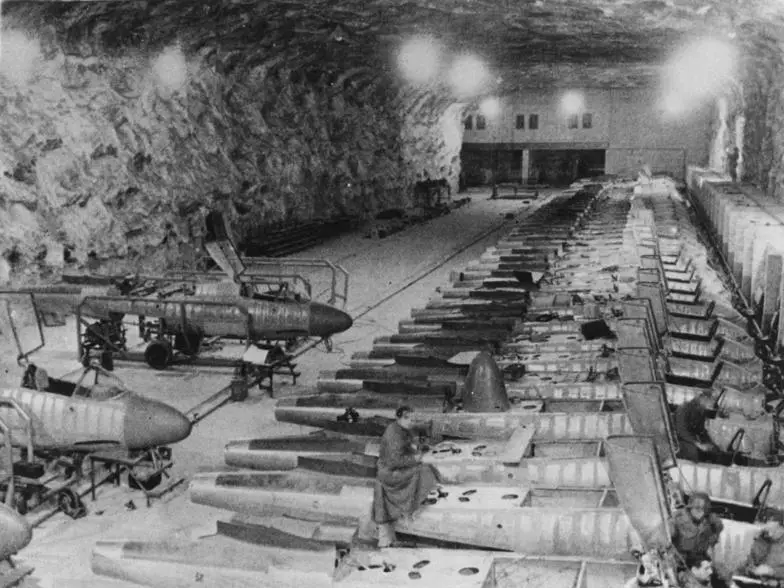
Underground He 162 assembly plant
However, due to interruptions in supplies, components and constant bombing, by the beginning of May 1945, Luftwaffe representatives had accepted approximately 120 vehicles, about a hundred ready-made interceptors remained in factories and warehouses, and another 500 vehicles were in the process of assembly.
There is no reliable information about the combat successes of the People's Fighters. According to German data, the He 162 shot down several British and American aircraft shortly before Germany's surrender. Our own losses were also very significant. In air battles, two He 162s were shot down, and more than ten aircraft crashed due to piloting errors, equipment failures and fuel consumption in the air.
The Salamander had a number of major shortcomings: the aircraft had very low directional stability, insufficient longitudinal stability at high speeds, a tendency to stall when flying at high angles of attack, excessive sensitivity of the rudders and low wing strength. With sudden evolutions of the control surfaces, the aircraft was prone to loss of control and, due to the threat of destruction, could not develop high speed near the ground.
After Germany's surrender, Soviet, American and British troops captured several dozen serviceable He 162s.
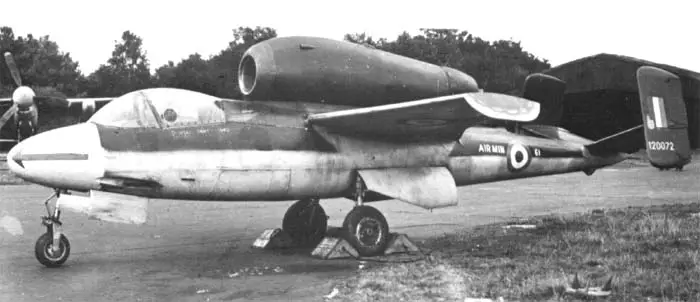
He 162A-2 interceptor at the RAF Farnborough test center
In 1945–1946 The Salamanders were tested in American, British, Soviet and French flight test centers.
In 1946, two He 162A-2s were tested in the USSR. The specialists of the LII NKAP generally did not rate Salamander very highly.
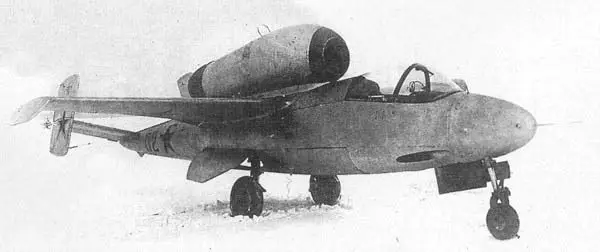
He 162A-2 interceptor being tested in the USSR
The report stated that the aircraft was difficult to control, had unsatisfactory flight characteristics, high drag, required a long take-off run and lost speed too quickly when the engine speed decreased.
At the same time, a number of technical solutions were considered worthy of attention. A revelation for Soviet designers was the pilot's catapult, powered by a squib. Retracting the landing gear and flaps using powerful springs was considered very ingenious. The thoughtfulness of the design solutions in the airframe and the manufacturability of individual components and assemblies were noted, which reduced the cost and simplified the manufacturing process.
Продолжение следует ...
Information